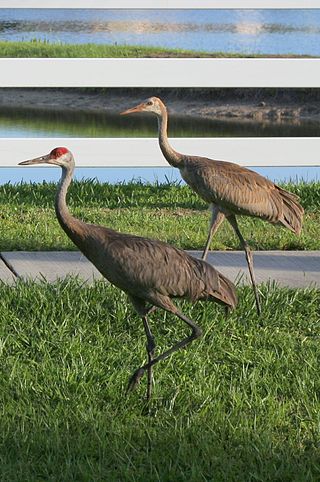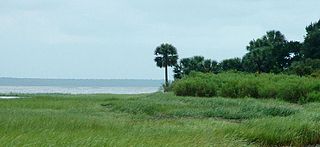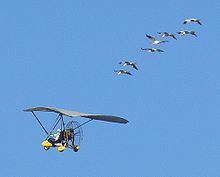
Fly Away Home is a 1996 family drama film directed by Carroll Ballard. The film stars Anna Paquin, Jeff Daniels, and Dana Delany. Fly Away Home was released on September 13, 1996, by Columbia Pictures.

The brolga, formerly known as the native companion, is a bird in the crane family. It has also been given the name Australian crane, a term coined in 1865 by well-known ornithologist John Gould in his Birds of Australia.

The common crane, also known as the Eurasian crane, is a bird of the family Gruidae, the cranes. A medium-sized species, it is the only crane commonly found in Europe besides the demoiselle crane and the Siberian crane that only are regular in the far eastern part of the continent. Along with the sandhill crane, demoiselle crane and the brolga, it is one of only four crane species not currently classified as threatened with extinction or conservation dependent on the species level. Despite the species' large numbers, local extinctions and extirpations have taken place in part of its range, and an ongoing reintroduction project is underway in the United Kingdom.

The greylag goose or graylag goose is a species of large goose in the waterfowl family Anatidae and the type species of the genus Anser. It has mottled and barred grey and white plumage and an orange beak and pink legs. A large bird, it measures between 74 and 91 centimetres in length, with an average weight of 3.3 kilograms. Its distribution is widespread, with birds from the north of its range in Europe and Asia migrating southwards to spend the winter in warmer places. It is the type species of the genus Anser and is the ancestor of most breeds of domestic goose, having been domesticated at least as early as 1360 BC. The genus name is from anser, the Latin for "goose".

Bird migration is the regular seasonal movement, often north and south, along a flyway, between breeding and wintering grounds. Many species of bird migrate. Migration carries high costs in predation and mortality, including from hunting by humans, and is driven primarily by the availability of food. It occurs mainly in the northern hemisphere, where birds are funneled onto specific routes by natural barriers such as the Mediterranean Sea or the Caribbean Sea.

The Canada goose, sometimes called Canadian goose, is a large wild goose with a black head and neck, white cheeks, white under its chin, and a brown body. It is native to the arctic and temperate regions of North America, and it is occasionally found during migration across the Atlantic in northern Europe. It has been introduced to the United Kingdom, Ireland, Finland, Sweden, Denmark, New Zealand, Japan, Chile, Argentina, and the Falkland Islands. Like most geese, the Canada goose is primarily herbivorous and normally migratory; often found on or close to fresh water, the Canada goose is also common in brackish marshes, estuaries, and lagoons.

The northern bald ibis, hermit ibis, or waldrapp is a migratory bird found in barren, semi-desert or rocky habitats, often close to running water. This 70–80 cm (28–31 in) glossy black ibis, which, unlike many members of the ibis family, is non-wading, has an unfeathered red face and head, and a long, curved red bill. It breeds colonially on coastal or mountain cliff ledges, where it typically lays two to three eggs in a stick nest, and feeds on lizards, insects, and other small animals.

The long-billed curlew is a large North American shorebird of the family Scolopacidae. This species was also called "sicklebird" and the "candlestick bird". The species breeds in central and western North America, migrating southward and coastward for the winter.

The sandhill crane is a species of large crane of North America and extreme northeastern Siberia. The common name of this bird refers to habitat like that at the Platte River, on the edge of Nebraska's Sandhills on the American Great Plains. Sandhill Cranes are known to hangout at the edges of bodies of water especially in the Central Florida region. This is the most important stopover area for the nominotypical subspecies, the lesser sandhill crane, with up to 450,000 of these birds migrating through annually.

The whooping crane is the tallest North American bird, named for its whooping sound. It is an endangered crane species. Along with the sandhill crane, it is one of only two crane species native to North America. The whooping crane's lifespan is estimated to be 22 to 24 years in the wild. After being pushed to the brink of extinction by unregulated hunting and loss of habitat to just 21 wild and two captive whooping cranes by 1941, conservation efforts have led to a limited recovery. The total number of cranes in the surviving migratory population, plus three reintroduced flocks and in captivity, now exceeds 800 birds.

The red-crowned crane, also called the Manchurian crane or Japanese crane, is a large East Asian crane among the rarest cranes in the world. In some parts of its range, it is known as a symbol of luck, longevity, and fidelity.
William Lishman was a Canadian sculptor, filmmaker, inventor, naturalist and public speaker, president of William Lishman & Associates Limited, Vice President of Paula Lishman Limited and Chair Emeritus of Operation Migration Inc. Described by the Toronto Star as a "dyslexic, colour-blind, wildly creative sculptor", he died less than two weeks after being diagnosed with leukemia.

Cranes are large, long-legged and long-necked birds of the order Gruiformes. Two species occur as wild birds in Great Britain: the common crane, a scarce migrant and very localised breeding resident currently being reintroduced to the country, and the sandhill crane, an extreme vagrant from North America. A third species, the demoiselle crane, has been recorded on a number of occasions, but these birds have not generally been accepted as being of wild origin.

St. Marks National Wildlife Refuge is one of the oldest wildlife refuges in the United States. Established in 1931 as a wintering ground for migratory birds, it encompasses 68,000 acres (280 km2) spread between Wakulla, Jefferson, and Taylor Counties in the state of Florida.

The 30,843 acres (124.82 km2) Chassahowitzka National Wildlife Refuge is part of the United States National Wildlife Refuge System, located on the west coast of Florida, about 70 miles (110 km) north of St. Petersburg. It is famous as the southern wintering site for the re-introduced eastern population of whooping cranes.

Necedah National Wildlife Refuge is a 43,696-acre (176.83 km2) National Wildlife Refuge located in northern Juneau County, Wisconsin near the village of Necedah. It was established in 1939 and is famous as the northern nesting site for reintroduction of an eastern United States population of the endangered whooping crane.

The Damara tern is a species of small tern in the family Laridae which breeds in the southern summer in southern Africa and migrates to tropical African coasts to winter.

The Muscatatuck National Wildlife Refuge is a National Wildlife Refuge located 3 miles east of Seymour, Indiana, on U.S. Route 50. Established in 1966, it comprises 7,802 acres in its main area of eastern Jackson and western Jennings counties, and an additional 78 acres (32 ha) in northwestern Monroe County, near Bloomington, Indiana, known as the "Restle Unit". It was established thanks to the selling of Federal Migratory Waterfowl Stamps, commonly known as Duck Stamps, by the United States Fish and Wildlife Service. It was Indiana's first National Wildlife Refuge. The name comes from the Muscatatuck River, which means "land of winding waters".
White Lake Wetlands Conservation Area (WLWCA), officially the White Lake Property, is a 71,905-acre tract of protected area located 7.4 miles (11.9 km) south of Gueydan at the south end of Louisiana Highway 91 in Vermilion Parish, Louisiana.

The International Crane Foundation (ICF) is a non-profit conservation organization that works to conserve cranes and the ecosystems, watersheds, and flyways on which they depend. Founded in 1973, the International Crane Foundation is headquartered in Baraboo, Wisconsin on a 250-acre property that includes live crane exhibits with 15 crane species, a visitor center, breeding facilities, a research library and nature trails. The foundation works worldwide and in the US with local partners to raise and conserve cranes. The Foundation maintains a regional base in China and shares program offices with partner organizations in Cambodia, India, South Africa, Texas, Vietnam, and Zambia. The International Crane Foundation's approximately 80 staff work with a network of hundreds of specialists in over 50 countries on five continents.

















